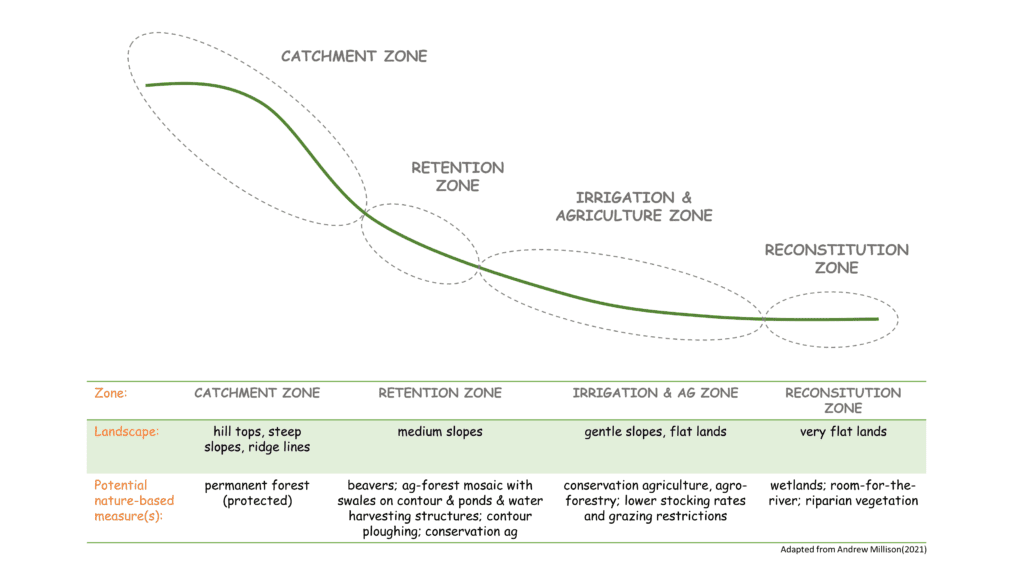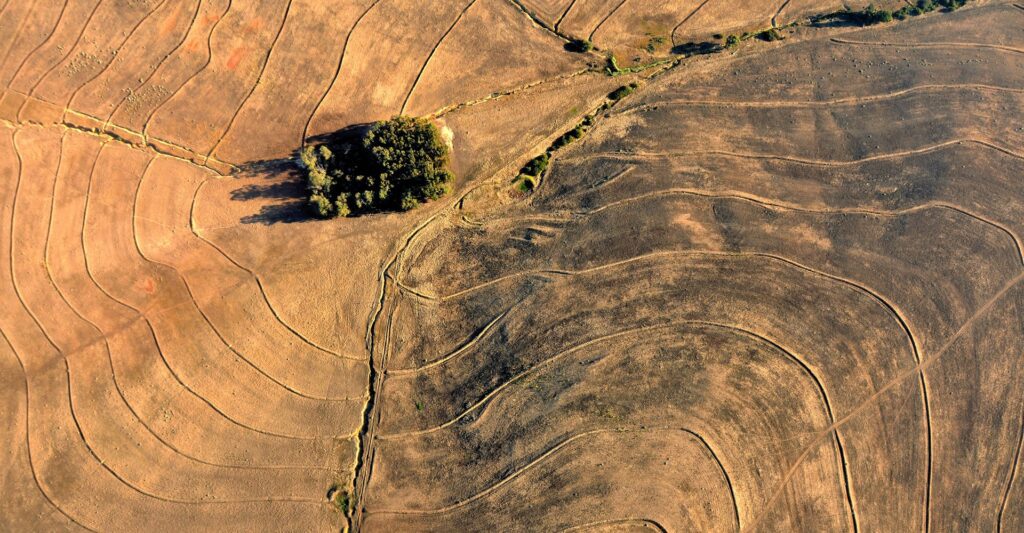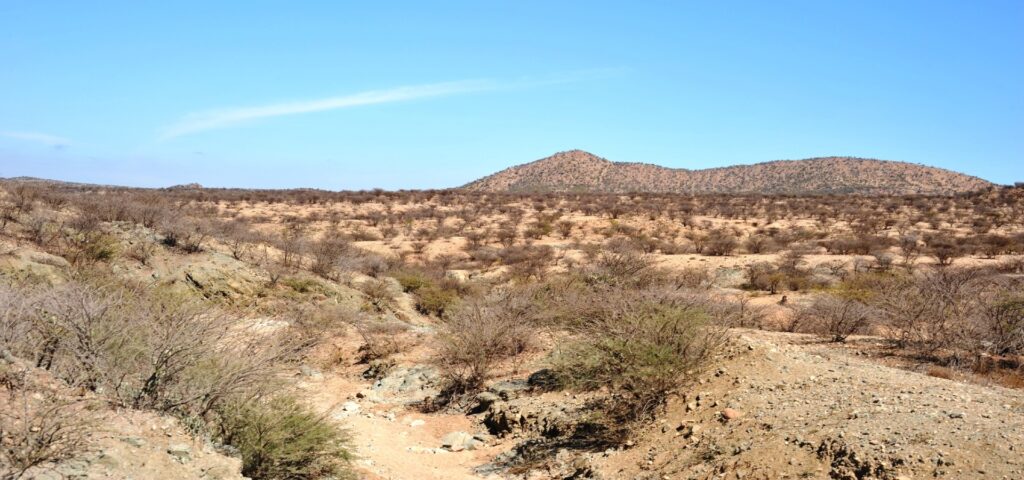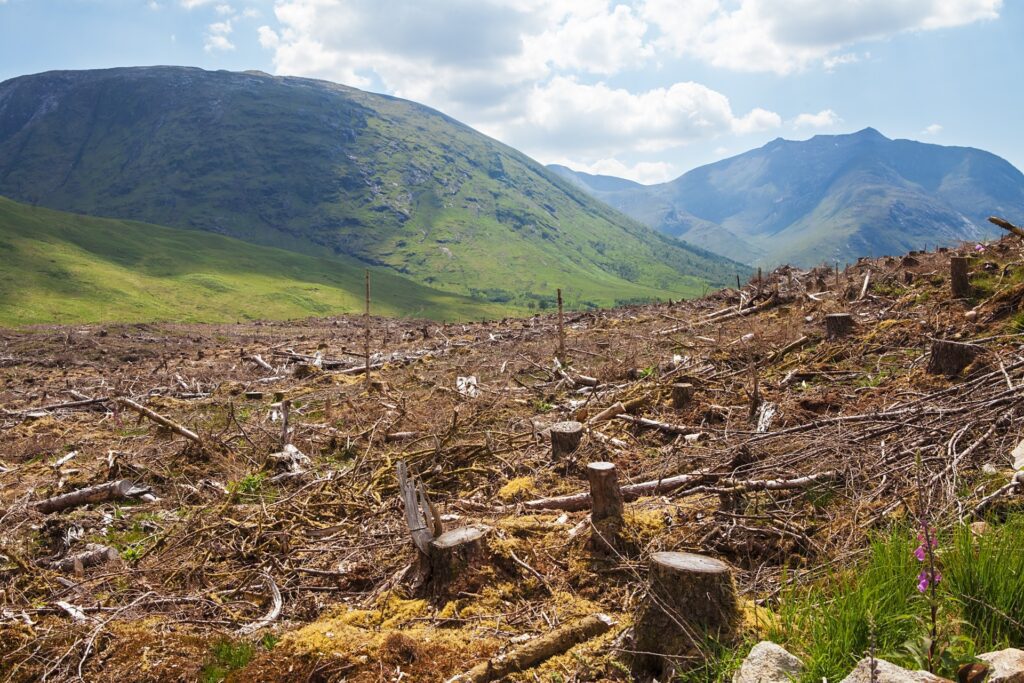There is a buzz about nature-based solutions. They are being promoted to achieve several key water resources objectives: enhance water availability, improve water quality, and reduce water-related risks.
Using nature-based solutions generally makes sense—mainly because water management is so closely related to land management. Afterall, the ‘fate’ of a raindrop is decided at plot level: will it runoff, percolate, evaporate, infiltrate? Will it cause erosion?
The hydrologic regime of a river in catchments with widespread land degradation will inevitably change. Runoff processes typically accelerate. It results in larger flood volumes with higher flood peaks, lower baseflow, and general drying of the landscape (in the tropical and sub-tropical climate zones). Climate change is expected to exacerbate these negative consequences of land degradation. Unfortunately, reversing or even arresting these processes at landscape scale is a massive undertaking that is typically beyond the capacity of a water resources or land management agency. Hence harnessing nature—which works ‘for free’; automatically scales-up if sensibly employed and left alone; regenerates and does not require maintenance—is something to examine and encourage.
But can nature-based solutions be employed for flood prevention in the dryland zone? Let’s explore.
What are nature-based solutions?
Nature-based solutions employ natural processes to achieve water-related objectives. In essence it is about management of vegetation, soils, wetlands, and floodplains with the aim to slow-down the speed at which water flows through the landscape. Water quality is improved along the way through biological processes. Most effective is to start at the top of the watershed.

A typical catchment with nature-based interventions is described below.
The upper parts of the catchment are kept in permanent forest that absorbs the energy of a raindrop. Rainfall infiltrates in the soft forest floor and there is little direct runoff or evaporation. Rainfall that is infiltrated in the spongy forest soil is slowly released to the rest of the catchment where it concentrates in small streams.

In the middle catchment reach—the retention zone—an agro-forestry mosaic with contour ploughing and conservation agriculture aims to minimize direct runoff and evaporation. Since this zone is often used for agricultural purposes but still has substantial slope, diverse water harvesting structures and swales on contour are needed to slow-down the speed at which water flows through the cultivated areas.
In North America, Europe, and parts of Asia, beavers—who also work ‘for free’—can dam creeks and streams and create an intricate and vast pond system that rehydrates the landscape.
In the agricultural zone, agro-forestry and conservation agriculture will minimize evaporation and encourage infiltration into the soil and recharge of aquifers. Agricultural practices and grazing restrictions should ensure that ground cover is always maintained.
Wetlands in the lowest part of the system buffer the flood wave, increase groundwater recharge, and remove pollutants. Riparian vegetation stabilizes the river channel and reduces channel erosion.
If properly employed, the above system will lead to healthy ecosystems that regulate and attenuate the hydrological cycle and keep water clean. Additional benefits include carbon sequestration, enhanced environmental value, and lower ambient temperatures.
‘reduce the speed at which water flows through the catchment’
When can nature-based solutions work?
I think there are three key requirements for nature-based solutions to be effective at landscape scale:
- Enough rainfall to sustain permanent forest and vegetation cover
- Adequate control over land use and land management practices
- The scale of the catchment and land degradation challenges should not overwhelm potential interventions (either nature-based or human-implemented)
The amount of rainfall needed to sustain a permanent vegetation cover differs per climate zone. It can be as low as 500 mm per year in the temperate zone, but some 700-1000 mm/year is required in the tropics, which have much higher evaporation potential. It is obvious that when the soil is bare and exposed to the elements—for instance at the end of the dry season—the effectiveness of nature-based solutions is low since there is not much left to regulate the hydrological processes, just when it is most needed.

That is why some level of control over land management practices matters so much. Without this, individuals can neglect sustainable land management practices or over-exploit the natural resource base. For communal lands this often leads to the ‘tragedy of the commons’. Nature-based solutions cease to regulate the hydrological processes once vegetation cover has disappeared. Hence establishing protected areas on hill tops and steep slopes—as happened in many countries—is a good example of how to promote nature-based solutions. Further, secure land tenure—in which farmers own the plots they cultivate—is a big ‘first step’ towards sustainable land management of agricultural land, with potential positive impacts on the hydrological cycle.
Scale matters because flow accumulates, and the erosive forces increase exponentially with catchment size. What works in a small watershed may not work in a large one.
The above does not imply that nature-based solutions have no purpose when conditions are not met. Rather, they no longer work as stand-alone solutions and must be complemented with civil works at various scales or other interventions.
the soil-moisture regime will determine the spatial patterning of the vegetation
Is there a role for nature-based solutions to reduce floods in the dryland zone?
The conditions in tropical drylands are unfavorable for nature-based solutions at larger scale. There is not enough rainfall to sustain a permanent vegetation cover while land-use is typically dominated by the pastoralist livelihood system on communal lands. For nature-based solutions to be successful in this environment, we need to find a new equilibrium between the (very fragile) natural resource base and its sustainable use. This implies changes to age-old traditional grazing rules on communal lands. While this is possible in principle, it is certainly challenging—specifically in periodic drought years. A complicating factor is that population densities are steadily increasing in this zone. Further, it has proven very difficult to restore these fragile ecosystems once they have been degraded. Hence quick results at scale should not be expected. At best, this is a long-term undertaking with only gradual impacts on flood volumes and flood peak.
Nature-based solutions can probably work for micro and small catchments—where communities have more control over land use—but certainly not at larger scale.
The high sediment load of rivers in the dryland zone is a complicating factor (note that sediment load is also high in dryland rivers when the landscape is not degraded). This river starts depositing sediment when it leaves the foothills and enters the flat lands—which is a popular area for irrigation and other economic activities. Incremental bed aggradation creates inverse topography, where the river is higher than the surrounding land. Embankment failure in this landscape leads to extensive and prolonged flooding, and water that has spilled to these lower lands cannot return to the river. Hence measures such as ‘room for the river’ do not work, as this river has no floodplain. Effective flood defenses, therefore, are critical.
In conclusion, the role of nature-based solutions in flood prevention for large(r) rivers in the dryland zone is limited in the short and medium-term. The jury is still out on whether they can work in the long-term—but it does not look too good. Thus, civil works are still our best bet in the face of this uncertainty. They won’t do much harm if long-term nature-based solutions prove successful. But at least they will provide some level of flood defenses for the people living in the riparian zone if nature-based solutions at landscape scale do not live up to their promise.
Note 1: “Old wine in new bottles?”. Maybe useful to note that—despite the buzz—there is nothing new about nature-based solutions. People have been doing this for a long time. A well-knows example is the response to the ‘dust bowl’ in the 1930s in the USA, when agencies such as the Soil Conservation Service (now the Natural Resources Conservation Service) were established. The SCS heavily promoted cover crops, tree wind breaks, reforestation, and other nature-based solutions. Further, many countries have protected hill tops and steep slopes to keep them under permanent vegetation. There are endless examples of long-term successful protection efforts of natural environments that have positively impacted on water security.

Note 2: this post did not discuss nature-based solutions in urban environments in the dryland zone—which are quite promising.
Note 3: in order to enhance sustainability, it is advised to create beneficial assemblies when implementing nature-based solutions.
Note 4: while generally beneficial, there are also counter arguments to nature-based solution; in Rwanda, for instance, water harvesting measures on steep slopes have led to an increase in landslides. Careful design is necessary.
REFERENCES
WWAP (United Nations World Water Assessment Programme)/UN-Water. 2018. The United Nations World Water Development Report 2018: Nature-Based Solutions for Water. Paris, UNESCO.
Andrew Millison (permaculture designer): diverse YouTube videos
